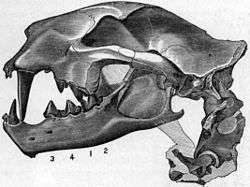Nimravus
| Nimravus | |
|---|---|
 | |
| N. brachyops skull | |
| Scientific classification | |
| Kingdom: | Animalia |
| Phylum: | Chordata |
| Class: | Mammalia |
| Order: | Carnivora |
| Suborder: | Feliformia |
| Family: | †Nimravidae |
| Subfamily: | †Nimravinae |
| Genus: | †Nimravus |
| Type species | |
| Nimravus brachyops Cope, 1879 | |
| Species | |
| |
Nimravus is an extinct genus of "false" saber-toothed cat in the family Nimravidae and subfamily Nimravinae, that was endemic to North America during the Oligocene epoch (33.3—26.3 mya), existing for approximately 7 million years.[1]
Taxonomy

Nimravus was named by Edward Drinker Cope in 1879. Two species are recognized, N. brachyops and N. intermedius.[2]
Unrelated to true saber-toothed cats, they evolved a similar form through parallel evolution.
Description
Nimravus was around 1.2 metres (4 ft) in body length. With its sleek body, it may have resembled the modern caracal, although it had a longer back and more dog-like feet with partially retractile claws. It probably hunted birds and small mammals, ambushing them like modern cats, rather than chasing them down. Nimravus competed with other false sabre-tooths such as Hoplophoneus.[3]
A single specimen was examined by M. Mendoza for body mass and was estimated to have a weight of 29.5 kg (65 lbs).[4]
Pathology
A Nimravus skull, found in North America, had been pierced in the forehead region, the hole exactly matching the dimensions of the sabre-like canine of Eusmilus. This particular individual of Nimravus apparently survived this encounter, as the wound showed signs of healing. Another Nimravus fossil from Nebraska was described in 1959 by paleontologist Loren Toohey, and comprises a Nimravus skull with saber-teeth embedded into the scapula of another Nimravus, indicating a fatal incidence of intra-specific combat.[5]
Fossil distribution

Fossils were uncovered in the western U.S. from Oregon to southern California to Nebraska.
References
- ↑ PaleoBiology Database: Nimravus, basic info
- ↑ Barrett PZ. (2016) Taxonomic and systematic revisions to the North American Nimravidae (Mammalia, Carnivora) PeerJ 4:e1658 https://doi.org/10.7717/peerj.1658
- ↑ Palmer, D., ed. (1999). The Marshall Illustrated Encyclopedia of Dinosaurs and Prehistoric Animals. London: Marshall Editions. p. 222. ISBN 1-84028-152-9.
- ↑ M. Mendoza, C. M. Janis, and P. Palmqvist. 2006. Estimating the body mass of extinct ungulates: a study on the use of multiple regression. Journal of Zoology
- ↑ http://www.smithsonianmag.com/science-nature/dakota-badlands-used-host-wild-sabertoothed-pseudo-cat-battles-180957841/